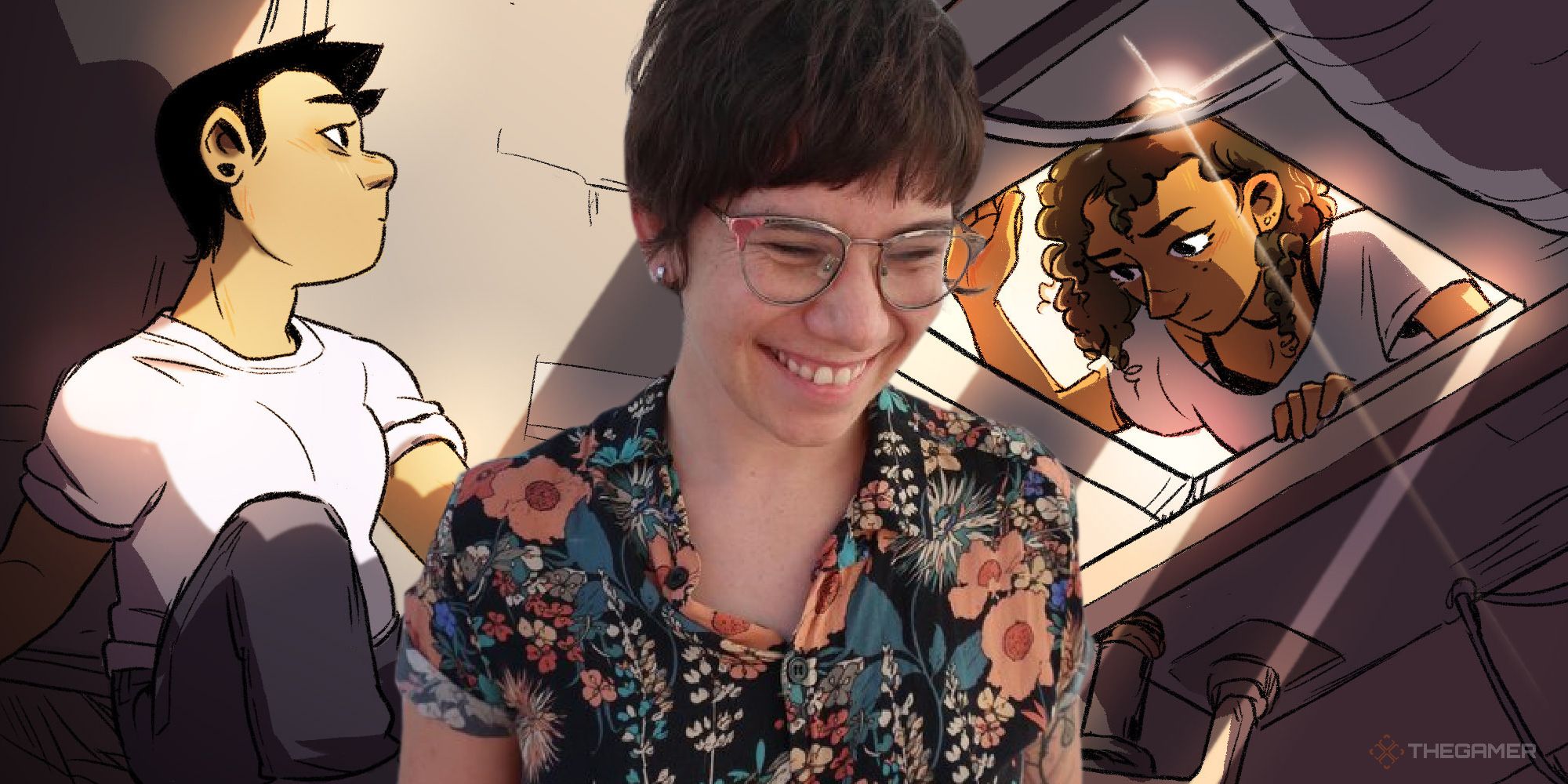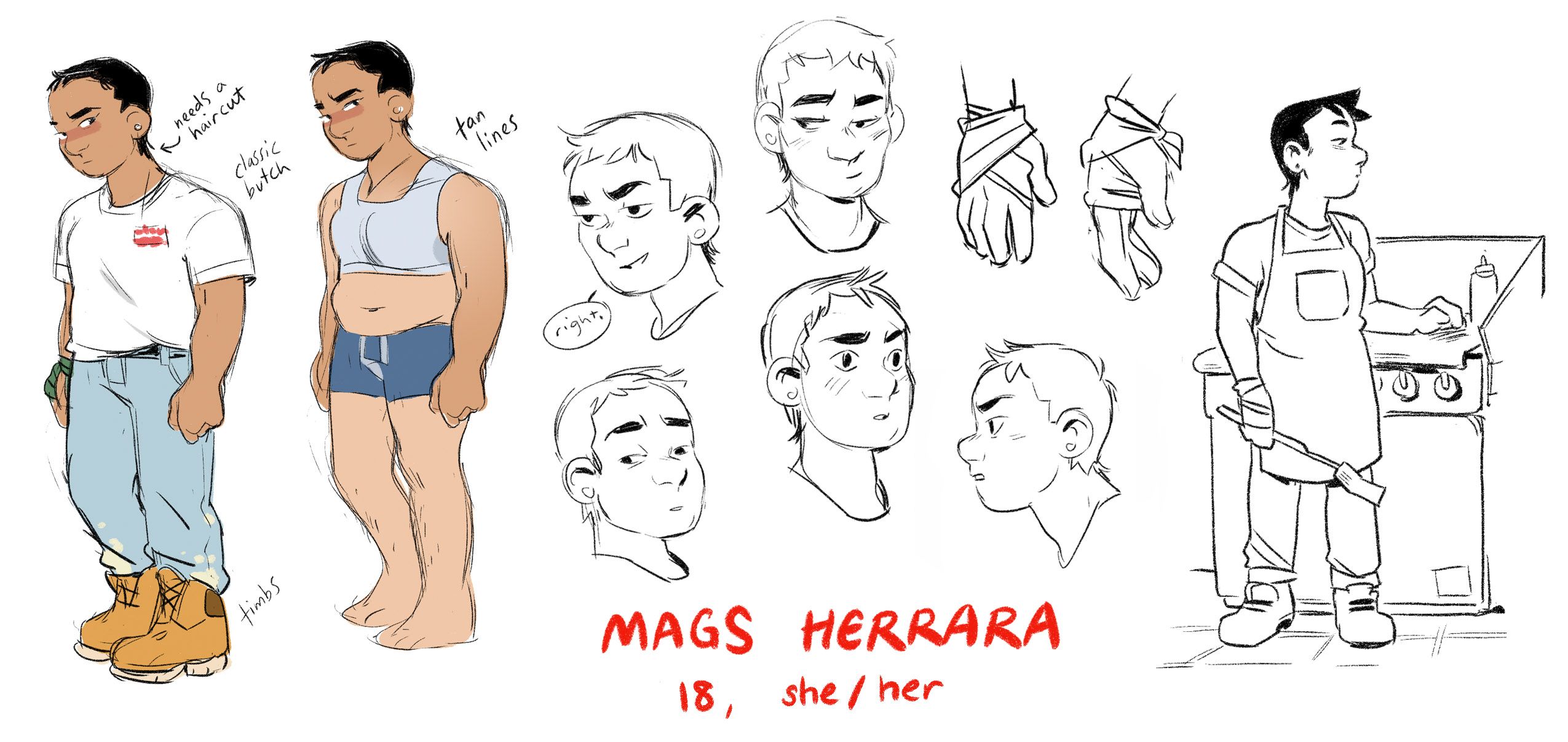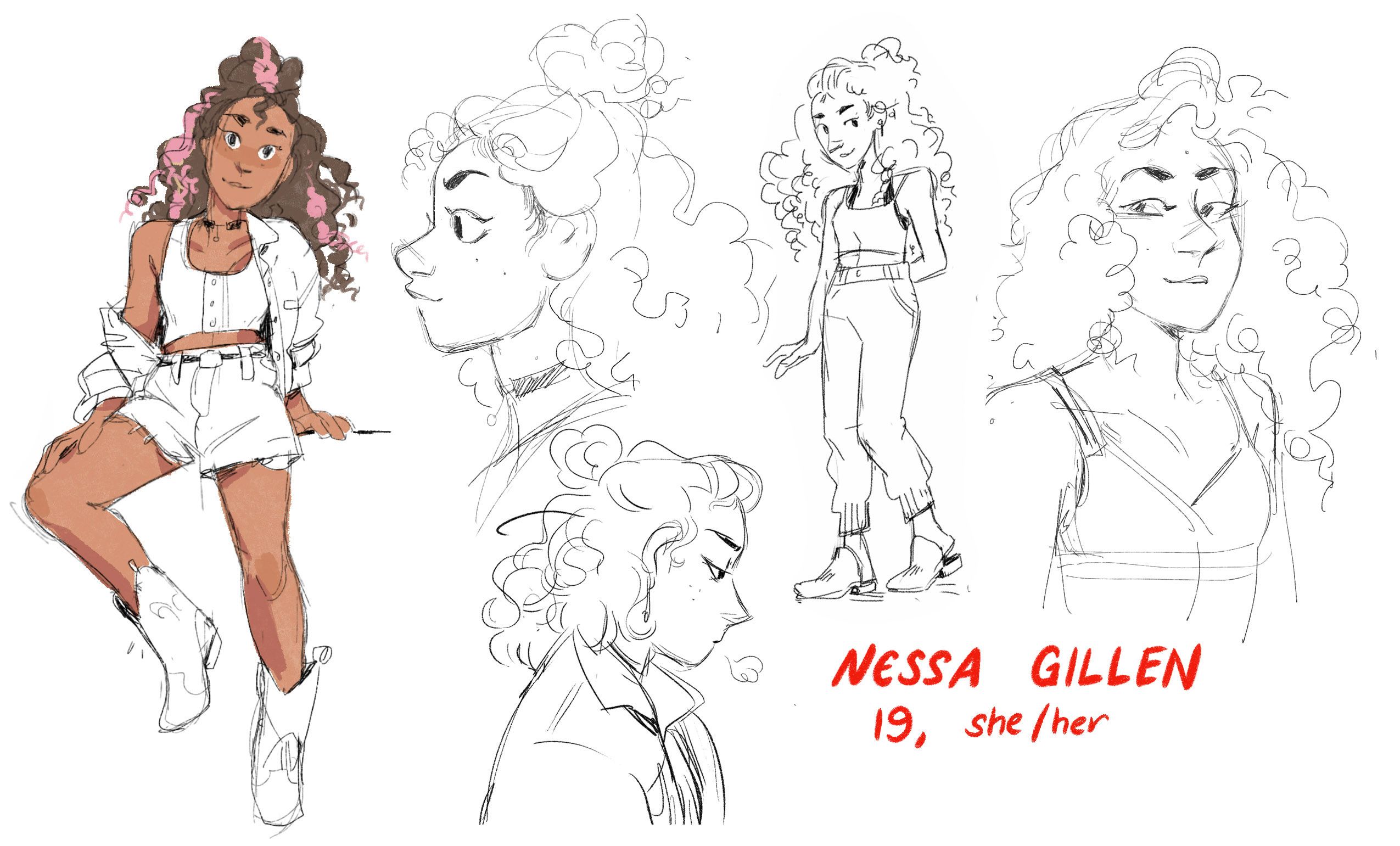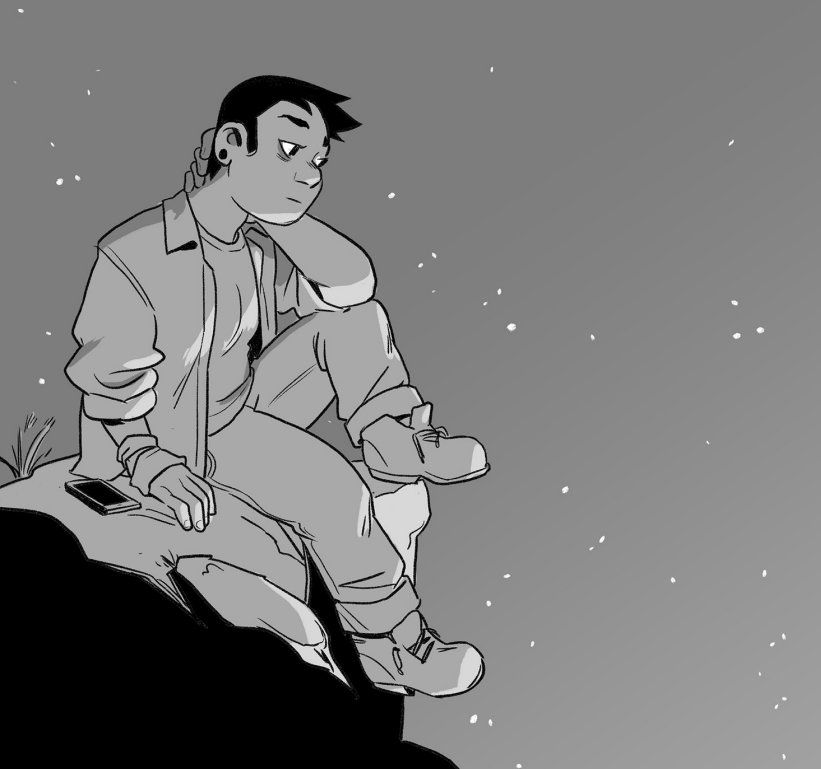“Darkest Night is a story about depression, family, childhood trauma, and an unravelling mystery,” Molly Knox Ostertag tells me about her new graphic novel, which recently debuted on her Substack. In a world where Twitter and Facebook lack the intimacy required to tell genuine queer stories, Ostertag saw this nuanced, subscription-based platform as an opportunity to both challenge herself and return to her roots of creating webcomics.
“It’s fun to go back to this format and remember what it feels like to build a community,” Ostertag says. “Substack approached me and offered me a grant to create a newsletter for them. My partner is doing slice-of-life comics but I was like, ‘I think I need to have a big narrative in order to put out content every week’ and [Darkest Night] is what came out of that. It’s cool to have a platform to put out work where I don’t have to advertise it super heavily or be tied into social media. Let it exist for people who want to see it and I can make exactly what I want. There’s something about controlling that space - after working in TV and publishing graphic novels, things leave your hands at a certain point and you can’t control where they go. This book will eventually go to a larger audience, but it’s really fun to be like, ‘It’s just for the couple of hundred people who signed up to the newsletter.’”
Having read the first chapter, Darkest Night tells a more mature tale than those of Ostertag’s previous work, yet it still appeals to adolescents on the cusp of adulthood. The Girl From The Sea is a touching sapphic adventure about two girls falling in love for the first time, while her work on The Owl House centres on a demographic who perhaps aren’t ready to explore the trauma that comes with growing up queer in certain communities. Darkest Night broaches on the messiness of being queer, exploring the blood, sweat, and tears that come with uncovering your identity and the happiness that eventually comes alongside it.
“I’m definitely trying to make something that’s meaningful to me and challenges my storytelling,” Ostertag explains. “After finishing The Girl From The Sea, I was thinking I could do another supernatural romance with queer teens and I was sorta brainstorming that out, but I’ve already done that. I know how to do that, I could do another one, and maybe I will eventually. I'm not saying I won’t. But I wanted to push myself and try something different. I’m maybe a third of the way through drawing [Darkest Night] and I love digging into the different trauma and habits you fall into where you’re that age and you’re queer. It’s really fun to explore that.”
Darkest Night centres on Mags Herrara, a butch heroine who doesn’t abide by any of the conventional norms of attraction we’ve come to associate with queer characters in the mainstream, and she’s beautiful because of that. “When we last spoke I said I wish I could put more butch characters in my work, and so it’s been really fun to draw Mags as a main character who is definitely a very classic butch which I love with all my heart,” Ostertag says. “She’s a character who carries burdens for a lot of people and I had a lot of growth in my own life where I went from building myself around other people to inhabiting my life more fully and realizing that I can actually be a much better person when I care for myself as well. She’s a character who can find herself caught up in serving people and being what people need from her.”
In the opening chapter Mags stumbles across Ava, a character who seems to treat our protagonist as a sexual object to be discarded the second her boyfriend rolls around. Yet it feels real, echoing the complications that often emerge when you’re a hormonal teenager discovering exactly who you want to be. “We’ll see more from Ava, who is more of a hook-up and definitely not her girlfriend. It’s a fling where Ava is wanting certain things from Mags and she’s getting pleasure out of being able to provide those for her, but she’s not having a romantic time, she’s being who other people need her to be. I think one of the central themes of the comic is depression, and how you seek your own feelings by trying to do what other people do instead of facing what you need to face.”
The central mystery in Darkest Night awaits in Mags’ basement. Each day she ventures down into the darkness, emerging with a tired look on her face and bloodied bandage around her hand. Ostertag didn’t say whether what awaits is supernatural or metaphorical, but believes this to be a more grounded story on human emotions rather than venturing into the fantastical.
“This is definitely the least supernatural book I’ve done, but there’s still some of that stuff in there,” she explains. “It's more of a magical realism story. We’ll definitely eventually go into the basement and see what it is but I’m structuring the story as a big mystery where I’m enjoying rolling things out, so it’s not exactly a twist or anything. It’s just deeply connected to Mags.”
Mags thankfully isn’t alone, with a childhood friend set to come back into her life in future chapters. Nessa Gillen is a trans girl who grew up in the sunny deserts of Joshua Tree before departing for the sprawling streets of Los Angeles to attend college. She’s hip, trendy, and ingrained in queer communities in a way that Mags simply isn’t. Once she discovers the troubles ailing her friend she is determined to help, and Darkest Night aims to explore the complications that come with surfacing one’s own emotional vulnerability. “We’re only on the first chapter so Nessa hasn’t come into it yet,” Ostertag notes. “But Mags is in a pretty dark place when she comes in and shines a light and forces her to look at things in ways she hasn’t before. That’s the dynamic I’m going for with them.”
While I won’t delve into the narrative for fear of spoilers, the first chapter concludes with a colourful flashback sequence featuring Mags and Nessa prior to her transition. Its fluorescent colours help to express a sense of childhood wonder that Ostertag tells me is very much deliberate: “I was excited to explore childhood flashbacks in this really luminous, glowing colour. I was using so many colour effects I’d never used before to make things as bright and shiny as possible. I think childhood memories sometimes feel like that - really sure and really bright in a way that we don’t feel about our lives anymore, especially as young adults. I also selfishly thought that I can’t colour this comic and have it coming out every week, so I can do a fun colour treatment with these memories as the story weaves into the present day.”
Nessa’s character and her relationship with Mags will develop in the months to come, with Darkest Night poised to engage with themes that Ostertag has said will be prefaced with content warnings as the narrative broaches upon ideas of trauma. “I worked with Mey Rude, who is a wonderful friend, and she helped me centre my work in a natural way that felt resonant and real to her [as a trans person],” she tells me. “Nessa also has her own problems and is bringing her own drama into the story, she is definitely not fully self-actualized. I think something I’ve learned from a lot of trans people in my life is that lesson of looking to yourself and caring for yourself, and having the courage to start walking down that path and being your true self, even if it is really scary. That’s what I wanted Nessa to bring into Mags’ life because you can make a choice to change your life and make a choice to be happier. She’s also just super cute and fun to draw and she’s always wearing great fashion.
“Mags is very closed off and it takes time for her to open up, but she has vulnerabilities that Nessa can pick up on pretty quickly. There’s a dynamic between them at the beginning where Mags isn’t willing to be vulnerable and Nessa doesn’t really want to poke her about it. So she’s like, ‘Okay, I’m just going to keep coming up to you and be like, what is going on and why are you so messed up?’ and they’re both keeping a lot from each other in different ways. The story is slowly unfolding and my favourite thing is just writing about two girls or two women talking about their feelings because you can’t necessarily have your life fixed by someone. You’ll have to read it to find out the rest!”
Nessa is also coming away from a toxic relationship, and thus Darkest Night will preface elements of her story with content warnings to ensure they don’t unintentionally trigger memories for queer readers. “I will have specific warnings for Nessa as these moments come up in the story,” Ostertag states. “She’s getting out of a really bad relationship, parts of which are very familiar to me and are drawn from my own life. That’s something I’ve always wanted to explore and coming from soft, sweet content like The Owl House, I don’t want readers to encounter things that upset them. The ability to do content warnings is such a cool thing about webcomics, it’s like tagging something on a fanfiction website. You’re making sure people aren’t seeing things they don’t want to while still allowing yourself to explore the complicated, messy, and ugly parts of life that sometimes happen. On the flipside, when you get to a certain point on social media, when you’re big, you feel like you’re always being annoying because everyone can see you whether you want them to or not. I know that I’m a voice in that community even if I don’t feel very qualified, and there’s something intimate about this comic where I’m like, you have to subscribe.”
Darkest Night takes readers to Joshua Tree, a picturesque National Park in Southern California with a different culture and atmosphere to Ostertag’s previous work. While it remains idyllic, there’s a deeper variety of themes and locations to explore that we’ve only scratched the surface of.
“It’s nearby and I’ve been to it so much and it’s like this really striking desert,” Ostertag recalls. “It’s beautiful, intense, and I’ve been camping there a couple of times. It’s really hot in the day and really cold at night, and then the stars are crazy clear, like everything is giant and it just feels so desolate. But when you look really close you’ll notice all these little creatures like jackrabbits, lizards, and birds that make it feel like such a beautiful and unique place. Me and my partner went on a little writing retreat and we stayed in this Airbnb with big heavy windows looking out and I would just climb rocks and think about stories because I wasn’t sure what I wanted to do next. And the story rolled into my head. Not quite fully formed, but the entire arc of the story came into my head as I was there.”
Darkest Night, whether we talk about its setting, characters, or wider queer themes, is faciliated by a platform that aims to be more personal. Ostertag is broaching deeper themes and a messier, more honest glimpse at the adult experience that doesn’t need to be prim and proper to be respected, and catering to an audience who understand and accept that seems to make the unfolding story so much stronger. It is uncompromising in its vision.
“The amount of followers I have on Twitter felt like a full-time job I hadn’t signed up for,” Ostertag tells me. “So I didn’t feel comfortable curating that space, and it’s hard because I don’t mind a homophobic troll in my mentions, but then I have all of these children following me and they’re kids, and when they see that they get upset. I like the idea of having a space that is much smaller, where I can filter those people out and have a chance to make it a safer place. The retweet function on Twitter is so big that when you’re making stuff you know it’s going to be stripped of its context eventually and people will take a comic and say, ‘Oh this is about my life now’ which is almost what you want, there’s a lot of comics out there which are very relatable and are meant to be shared. My passion has always been in longer narrative stuff that really needs to be built into a new context, and there’s not many places for that on the internet right now.
“I think it’s the eternal tension of posting work online and like all artists we all want to be seen. Something I realised is that I put so much thought and care into my work and everything that ends up being published or seen on a screen, and then I tweet a dumb thing I thought about 20 seconds ago and people are holding that to the same level as my published work. It was affecting my work and all the ways in which we are shown on a personal level and I don’t necessarily want to share that with the world in the same way I’m sharing these stories.”
You can check out Darkest Night over on Molly Ostertag’s Substack.



.png)
.png)

.png)
.png)
